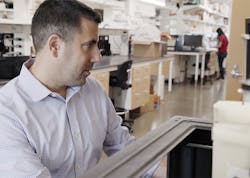Researchers Devise a Method to 3D Print Objects Out of Proteins
A research team at Carnegie Mellon University has developed a technique for 3D printing tissue scaffolds out of collagen, the major structural protein in the human body. This brings the field of tissue engineering one step closer to being able to 3D print organs and tissues.
The technique, called freeform reversible embedding of suspended hydrogels (Fresh), overcomes many of challenges a in 3D printing tissues and gives biomedical engineers higher levels of resolution and fidelity for printing soft and living materials.
Each of the organs in the human body, such as the heart, is built from specialized cells held together by a biological scaffold made of collagen—a protein—and called the extracellular matrix (ECM). This network of collagen provides the structure and biochemical signals cells need to carry out their normal function. However, until now it has not been possible to rebuild the ECM architecture using traditional fabrication methods, including 3D printing.
Researchers at Carnegie Mellon adapted 3D printing for bioprinting, which uses the technology to make tissues and organs, as they tried to construct working components of a human heart.
“What we’ve shown is that we can print pieces of the heart out of cells and collagen into parts that function such as a heart valve or a small beating ventricle,” says Adam Feinberg, a professor of biomedical engineering. “By using MRI scans of a human heart, we could accurately reproduce patient-specific anatomical structures and 3D bioprint collagen and human heart cells.”
Over 4,000 patients in the U.S. are waiting for heart transplants, while millions of others worldwide need hearts but are ineligible for the waitlist. The need for replacement organs is immense, and new approaches are needed to engineer artificial implants to supplement or replace the entire heart or just a few components.
“Collagen is an extremely desirable biomaterial to 3D print with because it makes up literally every single tissue in your body,” says Andrew Hudson, a biomedical engineering Ph.D. student and researcher. “What makes it so hard to bioprint with it, however, is that it starts out as a fluid. So, if you try to print this in air it just forms a puddle on the build platform. We’ve developed a technique that prevents it from deforming or dissolving.”
The Fresh bioprinting method lets collagen be deposited layer-by-layer within supporting gel bath, letting the collagen solidify before it is removed from the support bath. The support gel can be easily melted away by heating the gel from room temperature to body temperature after the print is complete. This way, researchers can get rid of the support gel without damaging the collagen structure or cells.
This method prints collagen scaffolds at the scale of human organs. And it is not limited to collagen, as a wide range of other soft gels—including fibrin, alginate, and hyaluronic acid—can be bioprinted using the Fresh technique to make strong, adaptable tissue engineering platforms. Importantly, the researchers also developed open-source designs so nearly anyone can build and experiment with low-cost, high-performance bioprinters.
“It is important to understand that there are many years of research yet to be done,” Feinberg adds, “But we’re making real progress towards engineering functional human tissues and organs.”

